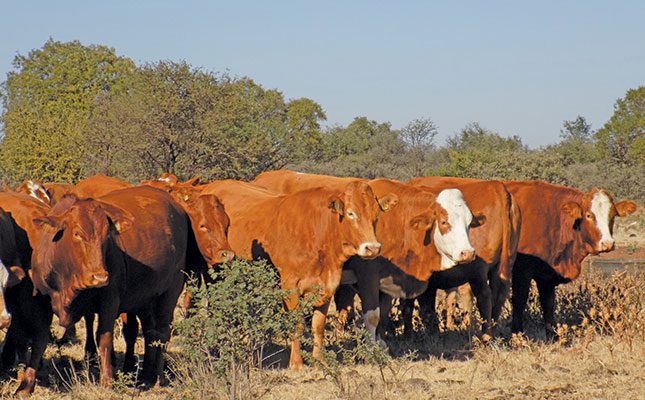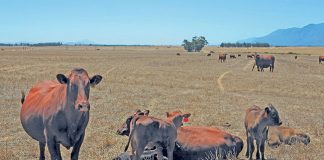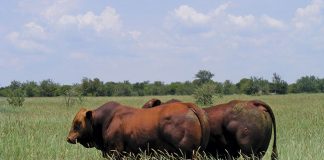
Photo: Annelie Coleman
In the early 1990s when Potchefstroom gynaecologist Dr Hentie van Rensburg took over the running of his family farm near Leeudoringstad, North West, the cattle herd was a mishmash of animals heavily influenced by the Afrikaner breed.
With the upgrading of his herd in mind, and incorporating Simmentaler genetics, he and his late herd manager, Lynton Vermaak, followed a strict process of selecting for traits that would ensure a financially sustainable herd. The result was an adaptable and uniform herd of Afrikaner-Simmentaler crosses.
Today, Van Rensburg and his son-in-law Lourie van Pletzen run the Demeter Afrisim Stud, which comprises 200 breeding females and 10 to 12 stud bulls.
The stud is run on two farms, Klipkop and Kareeboskuil, on a total of around 1 850ha. The grazing on the former consists mainly of red grass (Themeda triandra), while the Kareeboskuil grazing comprises a significant woody component of velvet raisin (Grewia flava), karee (Searsia lancea) and sweet thorn (Vachellia karroo).
The herd is kept on the Klipkop and Kareeboskuil veld in summer and winter respectively, and the stocking rate is approximately 6ha/MLU.
Afrisim studs in South Africa
Van Rensburg was one of the first Afrisim breeders to register a stud in South Africa.
“For many years, Afrikaner-Simmentaler was arguably one of the most popular crosses among commercial beef cattle producers […] It was therefore logical for breeders to formalise the business of Afrisim stud breeding,” Vermaak told Farmer’s Weekly in an earlier article (see FW, 22 July 2016).
The breed was registered as ‘a breed under evaluation’ in accordance with the Animal Improvement Act (No. 62 of 1998), and the Afrisim Breeders’ Society was finally founded in 2009 under the auspices of the Afrikaner Cattle Breeders’ Society of South Africa.
The average annual rainfall in the Leeudoringstad area is about 600mm.
Some 90ha is planted to dryland maize for silage and as winter feed, and around 40ha are planted to Smuts finger grass (Digitaria eriantha).Temperatures vary from below freezing in winter and in the high 30s in summer.
Elite cows
According to the Agricultural Research Council (ARC), cows that take part in the ARC National Best Elite Cow competition are judged on performance alone; visual appraisal therefore doesn’t come into play.
This award is contested among cows across all breeds, and only one cow per breed is chosen as the overall winner. Both registered and commercial cows are eligible to be entered.
Participating cows should exhibit exceptional reproduction figures and other important traits, such as age at first calving, average intercalving period [ICP], and days since last calving.
For commercial cows where no best linear unbiased prediction values are available, the evaluation criteria include the weaning indices for all calves weaned. The ARC states that the following additional criteria are used to identify the top-performing cow in each breed: breeding values for birth and weaning; average efficiency index, if available; percentage of the cows’ progeny approved for registration by the relevant breeders’ society; reproduction index; and the percentage of performance-tested calves.
Fundamental to success
Fertile, healthy, top-performing cows are central to profitable and sustainable beef cattle production, irrespective of the scale of the operation, says Van Rensburg. His advice to producers is therefore to cull any breeding female that doesn’t succeed in dropping and raising a calf every year.
Demeter’s JVR 08 058, winner of the 2022 ARC National Best Elite Cow award in the Afrisim category, is a prime example of the ideal breeding female. She is a feminine, medium-framed animal that is thoroughly adapted to excel on the veld, exhibits outstanding walking ability, and has a well-developed udder.
“This cow maintains an average ICP of 387 days, and has dropped and raised 11 strong and healthy calves so far. She gave birth to her first calf at the age of 36 months, and her offspring have an average weaning weight of 219kg.
“The quality of her offspring is underpinned by the fact that all of her female calves have been selected for the Demeter stud herd, and two of her bull calves have passed Phase D tests,” explains Van Pletzen.
Good maternal traits
For a cow to add value to any herd, commercial or stud, calving ease is a priority, especially since beef cattle production in South Africa takes place primarily under extensive farming conditions, says Van Rensburg.
Equally important are the dam’s ability to protect and care for her offspring, good milk production, and, of course, fertility.
Replacement heifers should be weighed at birth and weaning, and in the case of stud heifers, weaning indices need to be determined. This index refers to the evaluation of an animal’s potential, expressed as a percentage of the group average.
Heifers with weaning indices of less than 90% should be culled. The remaining heifers must be evaluated on functional efficiencies, and those that don’t make the grade should be culled.
“A good replacement heifer is feminine and shows the potential to develop into a medium-framed cow,” says Van Pletzen.
“Other vital selection criteria include a strong back, sufficient length and breadth, strong hooves and walking ability. In our herd, we retain about 20% of the heifer calves born every year as replacements.
“Droughts occur on a regular basis in the area where we farm. That’s why we give our heifers time to adapt fully to the veld conditions, and only mate them at two years of age.
“It’s essential that heifers drop their first calves when they are no more than 36 months of age. Allowing them to get too old before mating isn’t cost-effective, and could result in hormonal deficiencies.”
Heifer management
Demeter heifers that are ready to be mated are kept in a separate group on the best possible grazing available. They are supplied with salt and phosphate supplements in summer, and a mix of salt, urea, phosphate and maize meal after the first occurrence of frost in winter.
Van Rensburg stresses the importance of the body condition score scale in the selection process.
“If a heifer is too small at mating, she runs the risk of having too small a calf that could ultimately end up as a small-framed cow.
“On the other hand, a heifer that is too big is, more often than not, a poor performer
with impaired walking ability. Without additional feeding, big heifers and their eventual large-framed cow offspring will find it exceedingly difficult to perform well under veld conditions.
“For our heifers, we prefer to use bulls that tend to produce calves with lower
birthweights. This helps to mitigate the risk of calving problems in first-time calvers. Younger and lighter bulls are used on the heifers,” he explains.
At Demeter, an ICP of less than 400 days is another priority; anything longer than that begins to affect profitability. Variables such as unfavourable climatic conditions or bulls that get sick during the breeding season can push up the ICP.
Corrective pairing via single-bull mating is used to improve general cow efficiency. Bulls are run with the breeding females for 84 days in summer (between December and February) and for 72 days in winter (July and August). In summer, the heifers are mated two weeks before the cows, and remain with the bulls for only 72 days to afford them a longer period of recuperation before the winter breeding season begins.
Summer is the main breeding season, so calves are generally born in September. They therefore benefit from the advent of the rainy season in January, as well as the improvement in veld conditions when they start to graze.
As the calves grow older, their demand for milk increases, and their dams benefit from the better-quality grazing.
Sustainable reproduction
Since there is a correlation between weaning weight and birthweight, the Demeter team is not in favour of very large weaners, as heavy calves can cause difficulties for both heifers and cows during birth. Average weaning weights for Demeter bull calves and heifers are 234kg and 227kg respectively.
Van Rensburg says that by avoiding very heavy birthweights and the effects that large calves have on their dams, Demeter’s cows can easily stay in production until they are 14 years old.
Email the Demeter Afrisim Stud at [email protected].











